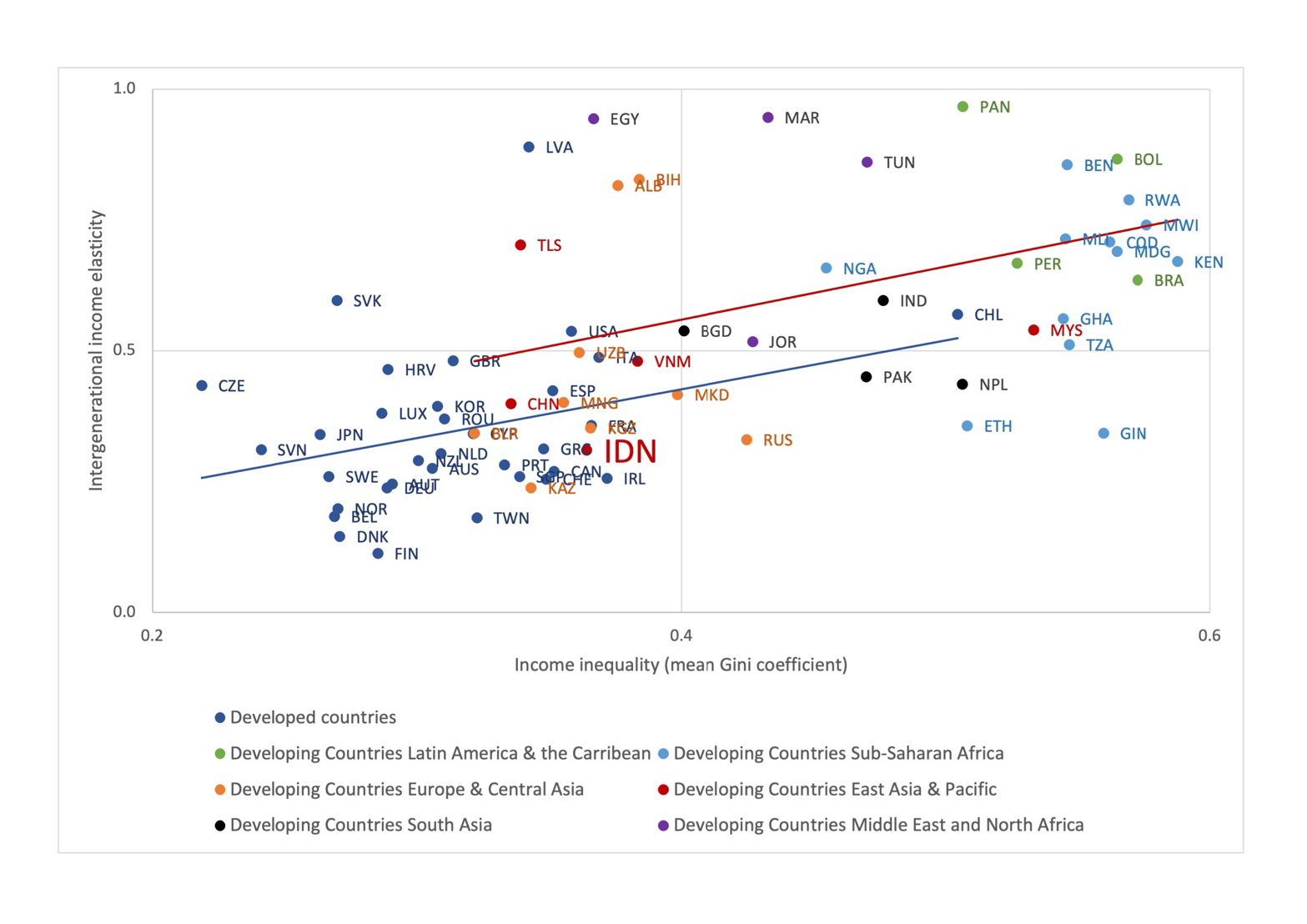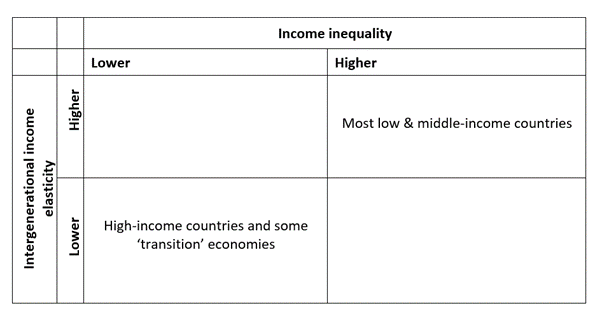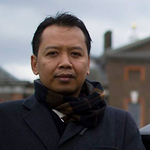Blog
The Great Gatsby Curve and the Global South
Time for a more ambitious redistribution and reparations agenda
The famous 1920s book The Great Gatsby, by F. Scott Fitzgerald, is the classic analogy for the American dream of meritocracy —that any person can achieve a better life regardless of their background— though the story illustrates the fragility of the dream. It also shows an age of prosperity just before the Great Depression. Although the novel shows how people from low-income backgrounds can move up in society, it also reveals the struggles and limitations that accompany upward mobility.
In the Global South, the question of economic mobility is an important topic for research, with major consequences for policy. In short, mobility is about the extent to which children’s economic outcomes are independent (or not) of their parents’.
Fitzgerald’s novel is embedded in the discussion of mobility and inequality through what has become known as the Great Gatsby Curve, which plots levels of income inequality against intergenerational mobility.
In our new book, we build on recent UNU-WIDER work in this area. We survey the area, discuss the Great Gatsby Curve, and consider whether and how countries in the Global South differ.
The Great Gatsby Curve
What the Great Gatsby Curve shows is that in more unequal countries it is harder to move up the income ladder. For example, in countries with lower income inequality (e.g., Finland, Norway, Denmark, or Sweden), the tie between parental economic status (measured by income) and the adult earnings of their children is weak: less than one-fifth of any economic advantage or disadvantage that a father may have had in his time is passed on to a son in adulthood (unfortunately, most estimates are father-to-son, but elsewhere we find major gender differences).
In contrast, in countries with higher inequality (e.g., the United Kingdom, the United States, and crucially, much of the Global South), advantage or disadvantage is passed down to children. In other words, the tie between parental economic status and the adult earnings of their children is strong.
We could say inequality is sticky. In more unequal societies, children of parents with comparably low incomes are much more likely to end up in relatively low-income positions. This challenges the idea that unequal societies are meritocracies, since economic outcomes are associated with parental background (i.e., class) rather than with individual effort and talent.
Figure 1: Intergenerational income elasticity (IGE) (father-to-son) versus mean Gini, years 0–20

Note: Global North countries (blue line of best fit) versus Global South countries (red line of best fit). The chart includes a new estimate for Indonesia (IDN).
What does this mean for inequality and mobility in the Global South? For these countries, fewer mobility estimates have been made, although mobility matters more in terms of the ability to progress to higher standards of living above any absolute poverty line. A major constraint for analysis of intergenerational mobility in countries of the Global South is the absence of recent representative longitudinal data. Only longitudinal analysis reveals changes occurring in the same household tracked over time.
And it is only possible to estimate various measures of economic mobility across generations when longitudinal data is collected for sufficient time to account for at least two generations (parents and their children). As a result, information is more limited for mobility measures than it is for, say, income inequality measures.
What do we find in our book?
We have three takeaways.
First, with only a few exceptions, the values in the Great Gatsby Curve show that high-income countries exhibit higher mobility and lesser inequality, and that the opposite is true for low- and middle-income countries, except for some transition economies. In Figures 1 and 2, we see that the data show the preponderance of rich countries in the bottom-left quadrant (lower inequality and greater independence of children’s incomes from parental incomes). There are also several transition or upper-middle-income economies in this quadrant. By contrast, countries in the Global South are mostly in the top-right quadrant.
Figure 2:The stylised relationship between income mobility and income inequality

Note: A lower elasticity = higher mobility
Second, we find that when we plot a (linear) line of best fit, it is higher for the group of countries in the Global South compared to the line of best fit (linear) for high-income countries. In other words, if we take those lines then at any given level of income inequality, meritocracy is weaker in the South than in the North.
Third and ‘so what?’ We think these findings imply an imperative for a greater focus on redistribution measures that support the countries of the Global South to achieve fairer societies. Furthermore, this imperative may be stronger today than it has been for other countries in the past because today’s developing countries may be less able to move from the upper-right quadrant to the lower-left quadrant due to shifts in the patterns of structural transformation.
Whereas today’s high-income economies moved along an earlier pathway from agriculturally-intensive to manufacturing-intensive economies, a more recent pattern or variety of structural transformation is from agriculture to lower-productivity services. For example, recent UNU-WIDER research raises bigger questions for how to manage inequality during economic development (see also the forthcoming volume on ‘Varieties of Structural Transformation’ from Kunal Sen).
What does a new agenda for fairness look like?
Almost 50 years ago Chenery et al.’s call for ‘Redistribution with Growth’ laid out an ambitious agenda. It advocated for asset redistribution, income transfers, and public investments with a focus on productive capacity and raising the incomes of the poor. Crucially, this requires the deliberate adoption of the twin objectives of both redistribution and growth.
This has the potential to be applied at the global level too, in actions such as increasingly inevitable post-pandemic debt relief and reparations for colonialism, slavery, and climate loss and damage (noting there is a new UN fund), potentially opening the political space for a discussion on the bigger question of reparations (for the latter). Indeed, it is becoming more evident that international redistribution in the form of greater concessional finance and/or relief from debt-servicing is needed in the coming years to ensure scope for social spending to expand, not contract.
Our findings point toward the importance of a renaissance of radical redistributive and reparations agendas. This is the most likely pathway to have any hope of achieving the poverty-related SDGs.
While Gatsby’s meritocratic dream of climbing the social ladder ultimately proved to be questionable, our findings show that for countries in the Global South, and with the right redistributive policies, it needn’t be so.
Diding Sakri is Independent Commissioner of West Java and Banten Regional Development Bank, Indonesia.
Andy Sumner is Professor of International Development at King’s College London and a non-resident senior research fellow at UNU-WIDER.
Arief Anshory Yusuf is Professor of Economics at the Department of Economics, Padjadjaran University, Indonesia a non-resident senior research fellow at UNU-WIDER.
The views expressed in this piece are those of the authors, and do not necessarily reflect the views of the Institute or the United Nations University, nor the programme/project donors.
 Join the network
Join the network












